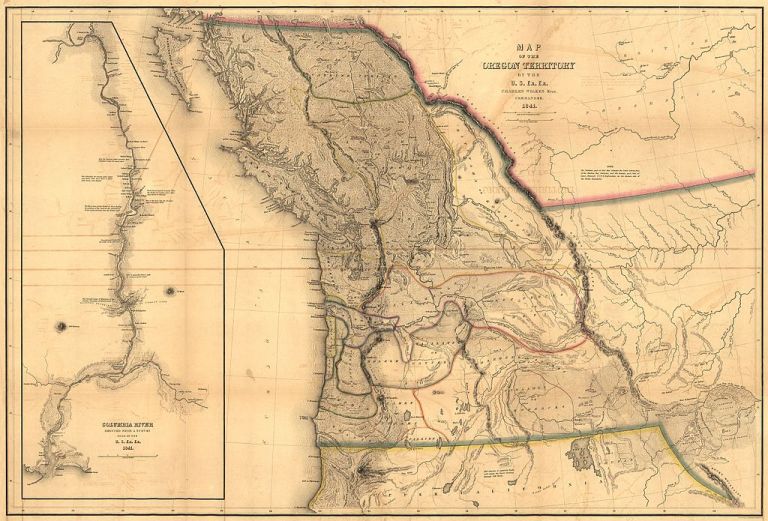Commencement Bay and just about every other geographic placename in the Puget Sound region not labeled by British or Spanish mapmakers came from the American expedition led by Captain Charles Wilkes in 1841. Historians and writers largely disregard the importance of the four ship expedition, partly because Wilkes was an insufferable, arrogant twit and partly because the First American Exploring Expedition (as it was formally known & U.S.Ex.Ex. as it was abbreviated ) became a very complicated military and diplomatic story. The most commonly mentioned accomplishment of the four year adventure was the first celebration of the 4th of July west of the Mississippi River, a deliberately patriotic cannon firing party that was held on the shore of Sequalitchew Lake within the perimeter of JBLM today. Two notable discordant aspects of the event are that the Americans celebrated the holiday on July 5th (the 4th was the Sabbath and the company partook of grog) and the most notable participant was not an American.

The life of the party that day was a Fijian chieftain and captive named Vendovi. Wilkes had seized him a year before in May 1840 when the naval squadron landed at Fiji specifically to bring American justice to the South Pacific island. The particular infraction of American law which led to Vendovi’s arrest had to do with the disappearance of the entire crew of the U.S. whaling vessel “Charles Daggett”in 1833. Without going into culinary detail, Vendovi took the fall for his people and was charged with cannibalism.
In the American’s custody, Vendovi quickly became a popular mascot among the sailors and was able to travel on different ships in the small fleet during the voyage. Compared to the irascible Commander Wilkes, Vendovi was an inquisitive, wise and playful presence. He quickly learned new languages, musical instruments and songs. He helped the artist Alfred Thomas Agate (Agate Passage is named for him) with the details of his botanical and scientific drawings and matched his seagoing navigation skills against the sextant and compass used by the trained navigators.
By the time the expedition reached Discovery Bay at the entry to Puget Sound in May of 1841 Vendovi had even learned how the Americans made maps. And indeed, mapmaking was the prime objective as Wilkes guided the massive flagship USS Vincennes down the sound towards the British post at Fort Nisqually.

The Hudson Bay Company traders who represented the land claims of the British empire in the Pacific Northwest were both friendly and leery when the Americans started mapmaking at the mouth of the Puyallup River by naming the bay Commencement and then designated the point between them as defiance. That summer, the U.S.Ex.Ex. mapmakers created a detailed and beautiful set of charts recording every shoreline, anchorage and sounding we know today as Puget Sound. They gave names to places as small as Day Island and collected everything from snail shells to bone whistles and woven baskets. Overland excursions took Wilkes to meet the legendary John McLaughlin on the Columbia River and sent botanists to Grays Harbor and exploring details east of the Cascades. The Americans had shown up big time in a vast part of the unmapped world that was considered jointly occupied by England and the United States. And to make the point unequivocally, they celebrated Independence day within cannon shot of the British stronghold.
Not all of the symbolic and diplomatic meaning of the festivities  on July 5th, 1841 were understood by Vendovi, or the American officers and crew for that matter, but just five years later the boundary between American Territory and Canada was established at the 49th parallel rather than the Columbia River. Today, Joint Base Lewis-McChord restrict public access to the site and monument where the geography of the Northwest was changed so dramatically and where Vendovi danced and marched in the mud in gum boots to the delight of the American explorers. But while Commander Wilkes largely ignored the Polynesian wayfarer, his mapmakers charting the San Juan Islands chose not to forget the small island king. They marked an island just south of Lummi Island with his name and recently it was purchased by the San Juan Preservation Trust. Today it belongs to the public and would be a great place to celebrate the 4th of July and perhaps have a bite to eat on the beach.
on July 5th, 1841 were understood by Vendovi, or the American officers and crew for that matter, but just five years later the boundary between American Territory and Canada was established at the 49th parallel rather than the Columbia River. Today, Joint Base Lewis-McChord restrict public access to the site and monument where the geography of the Northwest was changed so dramatically and where Vendovi danced and marched in the mud in gum boots to the delight of the American explorers. But while Commander Wilkes largely ignored the Polynesian wayfarer, his mapmakers charting the San Juan Islands chose not to forget the small island king. They marked an island just south of Lummi Island with his name and recently it was purchased by the San Juan Preservation Trust. Today it belongs to the public and would be a great place to celebrate the 4th of July and perhaps have a bite to eat on the beach.




Do you know what happened to Vendovi? Was he brought to some sort of justice for the charges? Did he jump ship?
LikeLike
Sad ending actually. He died just as the expedition reached home and his skull was given an identification number and added to the scientific specimens turned over to the just established Smithsonian.
LikeLike
Wow. Quite a story, sad ending and all.
LikeLike
Did you see this possible artifact from the US Ex. Ex.?
LikeLike